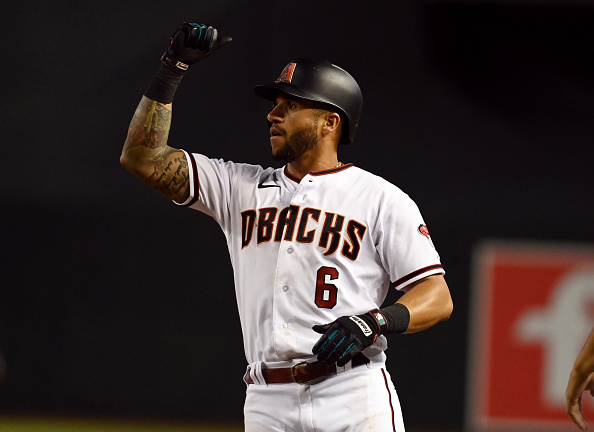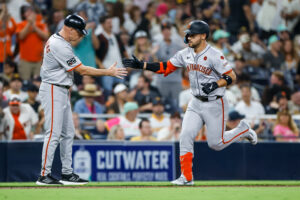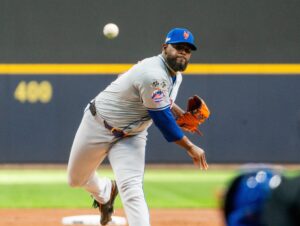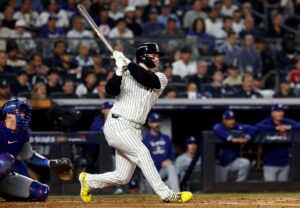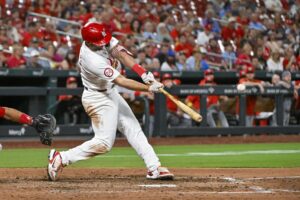Diamondbacks GM Mike Hazen Discusses David Peralta Trade
Trading a fan favorite is never easy. Neither is trading the longest-tenured player in an organization. On Saturday, the Arizona Diamondbacks did both, sending left fielder David Peralta to the Tampa Bay Rays in exchange for 19-year-old catching prospect Christian Cerda. “The Freight Train” has been a fixture in the community during his days with the Diamondbacks, working with charitable organizations and volunteering his time. Children are special to Peralta, and he could be seen time and time again visiting children’s hospitals with his trademark smile. The Diamondbacks signed Peralta, who had been given up on by the St. Louis Cardinals, from an independent league in 2013. He made the majors in 2014 and has not looked back.
But Peralta will soon be 35 and is in the last year of his contract. With so many young outfielders ready to play every day, this made Peralta one of the biggest trade targets around. The deadline is Tuesday, so calls began to flood general manager Mike Hazen’s office. Not long after making the deal, Hazen held a conference call with reporters and broadcasters to give more detail on the trade, the haul, and the thought process involved.
Basic Logic of the Trade
“We’ve talked a lot about this,” Hazen opened. “Given the position we’re in today, at least where we stand with regard to the standings, this (the trade) made sense for us on a couple of different levels.” Hazen acknowledged that the last part sounded “unfortunate.” He added that it is “not really our intention to want to be continuing or doing this again, trading off guys.” Instead, they are “hoping to be more pushing for a playoff spot as we move through the second half of the season. I’m hoping we’re winding that phase down here.
“But given where we stand today, we still have to make decisions that are in the best long-term interests of the organization. David is an impending free agent. The one area of our operation that I think you could pretty much confidently point to that we have more than our fair share of is left-handed-hitting outfielders, especially those that are playing the corner. So it made a lot of sense for us to make sure that a we made a trade to get a good player back and then open up opportunities for others that need to play that position as we move into the second half.”
Christian Cerda
The recent veteran-for-prospect trades the Diamondbacks have made near the Deadline were largely for players who were either major-league ready or were very close. Cooper Hummel has been back and forth between Arizona and Reno in 2022; he came in exchange for Eduardo Escobar in 2021. Josh VanMeter came in exchange for Archie Bradley in 2020; he saw significant playing time in 2021 before being let go. Now he plays regularly for the Pittsburgh Pirates. Josh Rojas came as part of the haul for Zack Greinke at the 2019 Deadline, debuted two weeks later, and, while healthy, has remained on the big-league roster ever since.
This one is different. Cerda is 19 and playing rookie ball. He is having a monster season, slashing .315/.464/.519 (17-for-54) thus far in the Florida Complex League with five doubles and two homers across 20 games. “Yes, we…recognize that a lot of the trades we have made over the last few years (have brought in) guys that would be contributing on our team or near to our team. We may still do some of those things, because those have been valuable trades for us in a lot of ways,” he said. The scouts saw Cerda — someone the team scouted extensively and tried hard to sign, ultimately losing out to the Rays — and how well he has progressed from the notes they had on him before. “Our scouts like a lot about what he brings to the table,” Hazen said.
Positional Demands
Hazen added that minor-league catchers “sometimes can be a little further away than other positions” simply due to the positional demands. “It’s not an area in our organization (where) we have guys moving up through the system as rapidly as we like. We wanted to continue to find opportunities to acquire these guys when we could.”
Catching is “a little harder to pin down” at earlier ages, Hazen added. “Because we’re looking for characteristics more than anything else. We’re still really projecting. Not entirely on this one, but when you’re scouting catching at that level, there’s just so much to the game that you have to learn through reps and otherwise. I’m a firm believer that — even the catchers you see up to the major league level — sometimes people look at and say, ‘Well, he’s hitting .250, has a .700 OPS. By and large, that could end up in the middle of the pack, offensively speaking, for catchers at the major league level. Those guys all hit in the minors. Acknowledging that it’s very early in the stage of performance, but (there) are a lot of characteristics that we liked.”
Other Possible Trades
At the time of this teleconference — 2:15 pm Arizona time on Saturday — Hazen said, “There’s nothing else standing right now.” But he added, “There are a lot of conversations. This (deal) came together pretty quickly in the last 24 hours. So whatever I tell you right now is subject to change 20 minutes from now. I apologize for that, but that’s just the way it goes. But as of right now, there’s nothing at or near what you would consider a finish line.”
Hazen could, however, make some statements on strategy. There are “multiple years of (team) control with almost everybody.” Consequently, they’re in a position now of “exploring, more than anything else.” He added, “There’s still quite a bit of interest in our players all across the board,” so it’s now a matter of “building forward.” There is a checklist of holes to fill in the offseason. If a deal can be made that fills one of those holes without creating others, that is the most likely to happen. “Creating holes I can’t fill is going to be a complicating factor in a trade for sure,” he said. (He didn’t say it, since he can’t, but this all but rules out Christian Walker going anywhere.)
“But it’s not going to be the only factor. If there is a really good baseball trade that I feel like, organizationally, we need to make and then roll the dice on what that’s going to be, we’ll have that conversation. Absolutely. I don’t feel like I’d be doing my job otherwise. But yes, where the 2022 and 2023 team are going to settle in, there’s still a huge value in what we’re going to do for the next two months.
Building for the Future through Current Growth
With the third hardest schedule in baseball — we play almost every one of the playoff teams all the way through — there’s a value in how we’re going to continue to play a good brand of baseball so these young kids experience that.
So the 2022 team is still of a lot of importance to me and to others I know. But (so is) the 2023 team. Creating a bigger to-do list in the offseason is probably not what I’m looking to do at the moment. I’ll probably look at it in the other direction. I’d like to be able to knock some of those things off going into the offseason. But like I said, we’re not gonna be closed-minded to things if there are trades out there that, organizationally, tip us over in certain ways.” These “certain ways” include depth and “long-term upside.”
What David Peralta Means to the Team
With Corbin Carroll blazing his way through the minors, the natural assumption is that this trade will make room for Carroll on the major league roster. Hazen, while not asked directly about Carroll, was asked if the team has “worked out internally” who will probably be the “next outfielder called up.” Hazen’s response was, “That outfielder is on our team already. Jake (McCarthy) is probably going to get the lion’s share of the opportunities right now in the outfield.”
*sad choo choo noises* 😥 pic.twitter.com/SFeiQNIUp9
— Arizona Diamondbacks (@Dbacks) July 31, 2022
McCarthy has big shoes to fill, something he acknowledged when he hit a double Saturday night. Upon reaching second, he made Peralta’s famous train whistle motion with a sad look on his face, then patted his heart. Peralta meant much to his teammates, the organization, the community, and the fanbase. “He brought energy, enthusiasm, and he’s a really good player for us,” Hazen said. “When I talked to him on the phone” — Hazen was not in Atlanta with the team — “we sort of walked through the thought process here, and he understood that, I think.”
The Sad Reality of Trading a Fan Favorite like David Peralta
“There’s the thought process in trading one of your players that we know is a fan favorite. Those are not easy trades to want to sign up for. But (we have) to remove that at times, with the thought being that there’s a new generation of fan favorites that, I hope, are starting right now. (I hope) people will see that on a nightly basis with some of the guys that are going out there and competing the way they are today.”
Young, talented, potentially popular players waiting in the wings did not make this any easier, Hazen acknowledged. “Knowing that there’s more coming in those particular spots doesn’t make it any easier to tell David Peralta that we traded him. Much like it wasn’t very easy to tell others prior to that. The way we’re trying to put this back together again in the immediate future, that position just is a tough position for us, given where a lot of our really good young players are. David and I joked about me needing to do a better job of getting more pitching instead of left-handed-hitting outfielders.”
Main Photo:
Players mentioned:
David Peralta, Christian Cerda, Cooper Hummel, Eduardo Escobar, Josh VanMeter, Archie Bradley, Josh Rojas, Zack Greinke, Christian Walker, Corbin Carroll, Jake McCarthy


